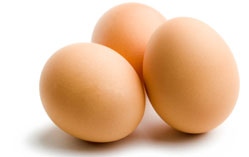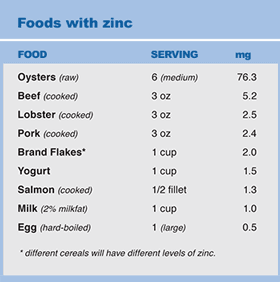Zinc
 Zinc is an essential trace mineral or "helper molecule." It plays a vital role in bringing vitamin A from the liver to the retina in order to produce melanin, a protective pigment in the eyes. Zinc is highly concentrated in the eye, mostly in the retina and choroid, the vascular tissue layer lying under the retina.
Zinc is an essential trace mineral or "helper molecule." It plays a vital role in bringing vitamin A from the liver to the retina in order to produce melanin, a protective pigment in the eyes. Zinc is highly concentrated in the eye, mostly in the retina and choroid, the vascular tissue layer lying under the retina.Impaired vision has been linked to zinc deficiency. A deficiency of zinc can result in poor night vision and cloudy cataracts. Other known effects of zinc deficiency include alopecia, or a loss of hair from eyebrows and eyelashes, along with mental sluggishness and increased susceptibility to infection.
Benefits to Eye Health
Zinc is recommended for individuals diagnosed as being at high-risk for age-related macular degeneration (AMD), or already experiencing the early stages of AMD. The human body does not synthesize the zinc it needs, which is the reason why red meat, seafood, poultry, eggs, wheat germ, mixed nuts, black-eyed peas, tofu, and baked beans are essential to good nutrition. Daily intake of zinc through diet, nutritional supplements, or fortified foods and beverages is important for the maintenance of good eye health.
Zinc and Age-Related Macular Degeneration
The Age-Related Eye Disease Study (AREDS), sponsored by the National Eye Institute, was a landmark study that established AMD as a ‘nutrition-responsive disorder.’ The study showed that a 40-80 mg/day intake of zinc, taken with antioxidants beta-carotene, vitamin E and vitamin C, slows the progression of advanced age-related macular degeneration by about 25 percent and visual acuity loss by 19 percent in individuals at high-risk for the disease. Higher levels of zinc may interfere with copper absorption, which is why the AREDS study also included a copper supplement.
Daily Intake*

The U.S. Food and Drug Administration (FDA) has established a dietary reference intake (DRI) for zinc of 11 mg/day for males and 8 mg/day for females. The AREDS study utilized high levels of zinc (40-80 mg/day) and showed beneficial effects for those at high risk for AMD. However, because high doses of zinc may cause stomach upset, a follow-up study, AREDS2, which is currently in progress, will be testing a more moderate dose of 25 mg. Zinc supplementation has been known to interfere with copper absorption, so 2 mg/day of copper is strongly recommended for individuals supplementing their diet with zinc.
Food Sources
The table above highlights good sources for zinc, which include red meat, seafood, poultry, eggs, wheat germ, mixed nuts, black-eyed peas, tofu, and baked beans.
References
- (2001). "A randomized, placebo-controlled, clinical trial of high-dose supplementation with vitamins C and E, beta carotene, and zinc for age- related macular degeneration and vision loss: AREDS report no. 8." Arch Ophthalmol119(10): 1417-36.
- Chew, E. (2007). “Age-related eye disease study 2 protocol.” National Eye Institute Protocol 07-EI-0025.
- Grahn, B. H., P. G. Paterson, et al. (2001). "Zinc and the eye." Journal of the American College of Nutrition20(2 Suppl): 106-18.
*At this time, the AOA is unaware of any studies that have examined interactions between specific medications and zinc. The AOA also is not aware of any adverse health reports from interactions between specific medications and zinc. However, the AOA recommends consulting with a health care professional before beginning any supplementation regiment.
